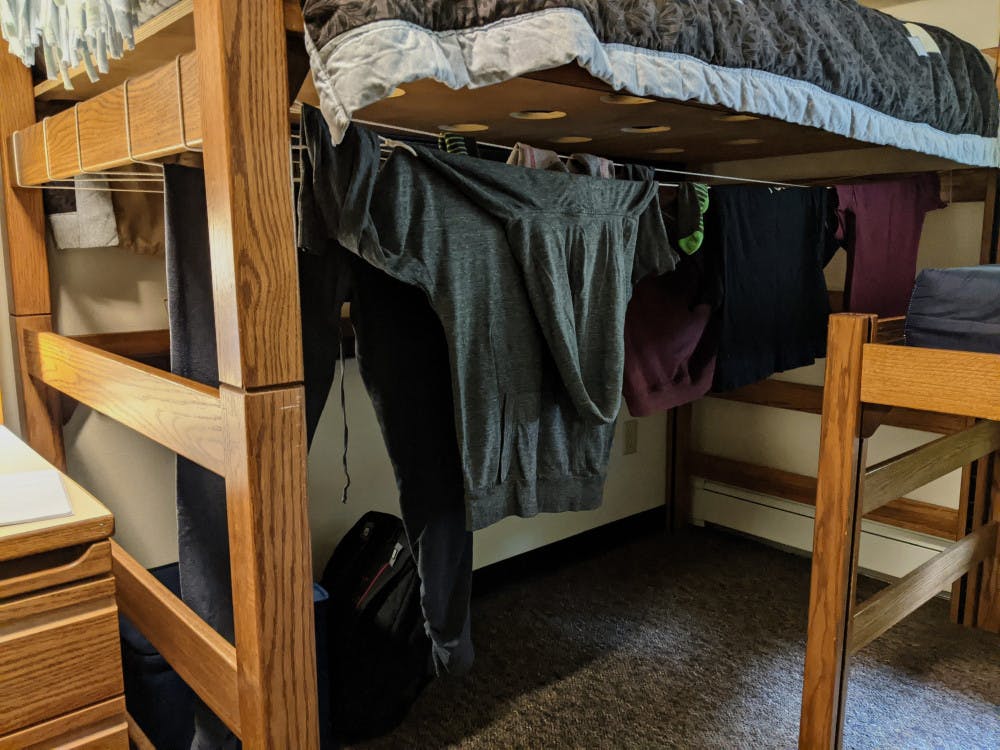Options for indoor drying systems include drying racks, pre-bought clotheslines or more DIY options

Between the cost of organic bulk food, sustainable fashion, electric cars, zero-waste toiletries and solar panels, sustainable living seems out of reach for anyone without an extra hundred or thousand dollars.
However, sustainability isn’t just about voting with your dollars, it’s also about everyday actions.
Choosing to air-dry clothes can lessen personal impact, costs virtually nothing and can even save money.
Dryers use the most energy per hour out of all household appliances, according to the Environmental Protection Agency.
In Bellingham, this energy likely comes from oil or a hydroelectric dam, said Alexander Bean, the president of WWU Energy Union and a fourth-year student.
Dryers also release microplastics into the environment, according to a 2020 study by Kirsten Kapp, a professor of biology sciences at Central Wyoming College, and Rachael Miller, founder of Rozalia Project for a Clean Ocean.
More clean energy and energy-efficient dryers designed with microplastics in mind can solve these issues, but college students don’t usually have control over the type of dryer they have or where the energy for it comes from.
Bean lives in a house from the ‘70s and said the amount of energy the dryer there uses is “super overkill.”
In Western’s dorms or apartments, the type of dryers available is determined by University Residences.
Residences Associate Director Kurt Willis said in an email that University Residences’ main concerns were reliability and energy efficiency when replacing the old laundry equipment in 2015.
However, Willis didn’t say how efficient the dryers were compared to other options. And regardless of how efficient they were in 2015, they are now five years behind.
To sidestep these issues, students can air-dry their clothes.
Kapp said she air-dries all of her clothes.
“[Idaho has] such a dry climate; I can hang my laundry outside, and it’s dry in an hour,” Kapp said.
Winter in Washington is the opposite of dry, but air-drying inside is still an option.
Will Barror, the president of WWU Net Impact and a fourth-year student, said he would be annoyed by a clothesline in his bedroom.
Finding a space that isn’t in the way can require creativity. For example, Kapp has a drying line rigged up near the ceiling over her computer.
Options for indoor drying systems include drying racks, pre-bought clotheslines or more DIY options like tying cords between tall things and hanging the clothes on spaced-apart hangers.
Because Washington is humid, clothes can start to smell musty. To avoid this, put a dryer sheet among the drying clothes or open a window when it’s not raining. Clothes also shouldn’t be dried near the bathroom or kitchen to avoid smells and moisture.
Air-drying also has practical upsides.
Using the dryer less reduces a person’s water and energy bill, makes clothes last longer and means fewer trips to the laundry room.
People don’t have to completely swear off drying machines either.
Like her co-author Kirsten Kapp, Rachael Miller usually air-dries her clothes. But the climate where she lives isn’t dry enough to air-dry her and her husband’s exercise clothes between daily workouts.
When air-drying isn’t practical, there are other ways to reduce the environmental impact.
Kapp said people should think before they wash.
“In American society, [we] have this throwaway mentality,” Kapp said. “My son does this … [he’ll wear clothing] for an hour, and I’ll find it in the dirty laundry pile.”
Willis said he thinks how students use drying machines makes more of a difference in energy consumption.
Are students running full loads or just drying a single pair of jeans?
Using the low-heat setting on an on-campus dryer can also save energy.
“Western’s campus itself is not powered with renewable energy, but they offset it with renewable energy,” Barror said. “If somebody lives on campus, they can feel slightly less guilty about drying their clothes with all this electricity.”
Individuals aren’t primarily to blame for climate change, but Barror said there will never be systemic change without personal change first. Students can take sustainable habits and awareness with them after they graduate and have more power to change regulations and businesses.
Ultimately, air-drying clothes isn’t enough to save the world. But we have to start somewhere, and it might even save you a bit of money along the way.





